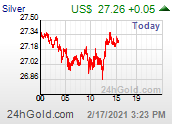Coeur d'Alene, Idaho (Platts)--25Sep2006
Whether or not the price of silver, along with gold, is being
manipulated to the downside by bullion banks and big
Wall Street traders was the subject of some disagreement at
the 4th annual Silver Summit in Idaho last week.
However, analysts told Platts they were unanimous on one
point: the silver price is headed seriously upward, fueled both
by fundamentals and near-historic levels of investor and
speculator interests.
"I am rabidly bullish on silver, and as we digest the first stage
of this bull market, we are poised to reach new real-time price
highs," said Sprott Asset Management's John Embry, adding that
he expected silver to be more volatile than gold but, in the end,
to outperform the yellow metal.
Embry continued: "As we slide down the slippery slope of credit
expansion, we will see further erosion of faith in fiat money.
The Federal Reserve will be faced with a monetary policy either of
deflation or hyperinflation as debt piles up. Hyperinflation will be
the more likely policy, and far from being a relic, silver will
re-assert itself as money."
Embry referred to a Sprott-issued report in 2004
entitled "Not Free, Not Fair in which he suggested that
in leasing gold banks and other major traders had conspired
to suppress the gold price.
At the Silver Summit he declared there was similar "obvious
price fixing" in the silver markets. "The silence of the silver-mining
companies in the wake of these manipulations must end," he said.
CPM Group's Managing Director Jeffrey M. Christian said he could
find no evidence of silver price manipulation, but said market forces
would drive the white metal's prices much higher than current levels
in the near term, should investor or speculator interest top 150 million oz.
"The silver market is shifting from 16 years of persistent net
sales from inventories to net purchases for addition to inventories,"
said Christian. "Investors are buying silver. The iShares silver ETF is
only a sideline, a consequence, of the surge of investor interest in silver."
According to Christian, the Indian government sold 35-mil oz
of silver in 2005, but sales could decline to 32.5-mil oz in 2006.
"Silver was legally re-exported from India in March and April 2006
after stocks of unsold new imports built up there," said Christian.
"The silver went mostly to dealer holdings in London, where the metal
will be available for delivery into the silver ETF."
Christian likened current market conditions to those of 1979,
when silver shot up to nearly $50/oz and the silver-gold ratio
dipped below 10:1. "This represents investors buying more silver,"
he said. Total silver bullion inventories, meanwhile, have fallen from
more than 2-billion oz in 1986 to nearly zero now, he noted.
--David Bond, newsdesk@platts.com
Whether or not the price of silver, along with gold, is being
manipulated to the downside by bullion banks and big
Wall Street traders was the subject of some disagreement at
the 4th annual Silver Summit in Idaho last week.
However, analysts told Platts they were unanimous on one
point: the silver price is headed seriously upward, fueled both
by fundamentals and near-historic levels of investor and
speculator interests.
"I am rabidly bullish on silver, and as we digest the first stage
of this bull market, we are poised to reach new real-time price
highs," said Sprott Asset Management's John Embry, adding that
he expected silver to be more volatile than gold but, in the end,
to outperform the yellow metal.
Embry continued: "As we slide down the slippery slope of credit
expansion, we will see further erosion of faith in fiat money.
The Federal Reserve will be faced with a monetary policy either of
deflation or hyperinflation as debt piles up. Hyperinflation will be
the more likely policy, and far from being a relic, silver will
re-assert itself as money."
Embry referred to a Sprott-issued report in 2004
entitled "Not Free, Not Fair in which he suggested that
in leasing gold banks and other major traders had conspired
to suppress the gold price.
At the Silver Summit he declared there was similar "obvious
price fixing" in the silver markets. "The silence of the silver-mining
companies in the wake of these manipulations must end," he said.
CPM Group's Managing Director Jeffrey M. Christian said he could
find no evidence of silver price manipulation, but said market forces
would drive the white metal's prices much higher than current levels
in the near term, should investor or speculator interest top 150 million oz.
"The silver market is shifting from 16 years of persistent net
sales from inventories to net purchases for addition to inventories,"
said Christian. "Investors are buying silver. The iShares silver ETF is
only a sideline, a consequence, of the surge of investor interest in silver."
According to Christian, the Indian government sold 35-mil oz
of silver in 2005, but sales could decline to 32.5-mil oz in 2006.
"Silver was legally re-exported from India in March and April 2006
after stocks of unsold new imports built up there," said Christian.
"The silver went mostly to dealer holdings in London, where the metal
will be available for delivery into the silver ETF."
Christian likened current market conditions to those of 1979,
when silver shot up to nearly $50/oz and the silver-gold ratio
dipped below 10:1. "This represents investors buying more silver,"
he said. Total silver bullion inventories, meanwhile, have fallen from
more than 2-billion oz in 1986 to nearly zero now, he noted.
--David Bond, newsdesk@platts.com






